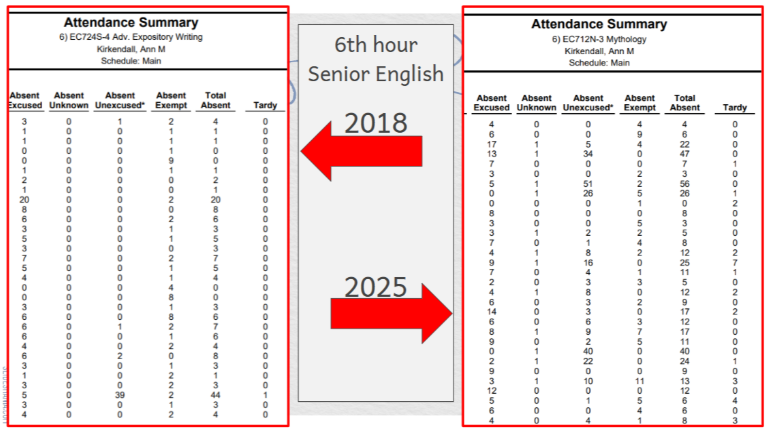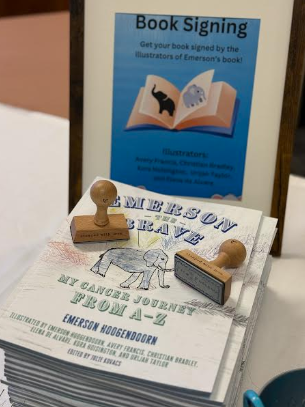The Michigan Interscholastic Press Association (MIPA) presented their annual awards on April 21. At the ceremony on the campus of Michigan State University, MIPA judges recognized three of the eight West Ottawan articles submitted for review. Following is each article.
1st Place in Division 1 — Informative Feature
Sting Operation by Emily Wallace
The warm aroma of black coffee fills the home as he sits with several others. He converses with them, socializing and enjoying himself all the while. In the midst of the chatter, he remembers why he is here. He remembers the first appointment. He remembers meeting the woman. He remembers her explaining how the process works. He remembers his first sting. Because he wasn’t allergic, he came back several times. Each time after, it was exactly like this. Sure, there were always different people circulating through, but the laid-back atmosphere was consistent, and so was the healing. It sounded like a sci-fi novel at first, but now he knew it to be real-life natural medicine. Apitherapy it is called, the use of products derived from bees as medicine, including venom, honey, pollen, and royal jelly. He snapped back to the room, and realized he’d be next. The woman came over, a jar of live honey bees in her hand, and asked him where he needed his treatment. Instructor Peter Schwallier pointed to his calf and received 5 bee stings on his lower left leg.
Six years ago, Schwallier started apitherapy; he discovered it through his father. In the beginning, he showed natural skepticism, but as time went on, he became more curious. “I thought he was crazy, but many of his prior injuries seemed to be healing. I had many recurring injuries from when I played tennis in college. . .[so] I decided to give it a try, and it helped immediately,” Schwallier said. Consequently, Schwallier found apitherapy to be a successful natural treatment for his own ailments and continues to use it today.
As an active tennis player and coach, Schwallier is prone to eventual muscle strain. In the event that he pulls a muscle, he pulls out the bees. “When this happens, . . . I’d be on the phone [that night] and would have box of 80 bees shipped to my house immediately. . . . I’ll sting the area with 5 or 6 bees three times a week until I feel better. I heal far quicker this way, so it usually isn’t more than a week or two [until I’m fully healed],” said Schwallier. The bee venom acts quickly after the stinging, penetrating deep layers of muscle and stimulating cortisol release from adrenal glands. The cortisol acts as a steroid that prevents inflammation through suppressing the immune system. Schwallier uses this natural reaction to his advantage to speed up the natural healing process.
Though he usually only receives the 5 to 6 stings three times a week, there have been several occurrences in which he has experienced stings in huge excess. “The woman who I initially went to to get stung gives out ‘free-bees’ on your birthday. One year, I decided to take full benefit, and was stung by 29 bees on my 29th birthday! That’s the most I’ve ever experienced at once,” Schwallier said. He recalled another time in which he had a foot injury that required heavier doses. “. . . for a month I was stung by 8 bees on each foot, 3 times a week,” Schwallier said. By increasing the dosage, he was able to care for his larger injury.
Schwallier follows a general procedure each time he stings himself now. He recommends that no one attempt this therapy without consulting a professional first, as venom can contain neurotoxins that alter nervous system activity if certain circumstances are met. “When I started, I used to ice the area first to numb it. Now that I know more about how it works, I have bees shipped to my house via UPS whenever I have an injury. . . and I just sting myself, I’m pretty used to it,” Schwallier said.
- I keep the bees in a mason jar. The top has holes in it so they can breathe, and a sugar cube in it so they have something to eat.
- Under the lid I have a wire gauze that’s held on by a rubber band, so the bees can’t just fly out when I take off the lid.
- When I want to get bees, I take off the lid, and use reverse tweezers to grab a bee (the wire gauze has a slit in it so I can stick the tweezers through).
- The bee is obviously mad when it’s on the end of tweezers, so it’ll sting the first thing it touches, which will be me. Honeybees are naturally very tame, so it’s really pretty easy.
From his students’ perspectives, the process does not seem as easy as he claims it to be. To the untrained eye, a supposedly levelheaded teacher who stings himself with bees willingly seems to not be so levelheaded. “I would imagine most people think it’s crazy, since that’s what I thought when I first heard about it. Every year or so I bring a jar of bees in and let my students sting me, and that’s always a fun day,” Schwallier said.
When students look into the science behind his action, some don’t see how the benefits overcome the negative of being stung. Others see the logic on his side. Whether one belongs to either group, it’s hard to argue against the wonders of the human body and natural medicine after hearing the healing testimony regarding Mr. Schwallier’s bees.
Honorable Mention (Top Six) in Division 1 — Informative Feature
The untold story of the snow day by Ethan Israels
Superintendent Tom Martin grabbed his briefcase and buttoned up his coat as he headed out of his office for the day. As he headed toward the door, he couldn’t help but notice the ever quickening fall of snow outside his frosty window at the Administration Building. Then he saw it – the neon green weather advisory note on his secretary’s desk – it was going to be a long night. Martin headed home to “Pay attention to the weather, watch it at dinner time, and for sure watch it at 11,” his normal routine when there is extreme weather predicted. As Bill Steffen uttered the last words to wrap up the 11o’ clock news, Martin switched off the television, headed up to bed, and set his alarm clock for 4:30 am. “All night I’ve got one eye open and you hear everything, the wind blowing and the whole thing.” As he drifted asleep he wondered if, and when, he would get a text from Transportation Director Paul Wegmeyer.
A few blocks away, Wegmeyer jolted awake to the rhythmic buzzing of his alarm clock. It was 4:05 am, time to hit the road. As he buttoned up his shirt, he walked over to his front door and flipped the switch on his outside lights. His suspicion was confirmed. Heavy snow was indeed falling from the sky. It’s 4:10 am, and Wegmeyer hustles out the door.
As Wegmeyer left his driveway and tapped the accelerator he could feel the street was slippery like a skating rink with frozen packs of snow. This situation definitely warranted a possible threat to the district. He pulled off the road and slid into a parking space to make his first call of the morning. Wegmeyer’s first call is to the National Oceanic and Atmospheric Administration station in Grand Rapids to speak with a meteorologist on duty. He speaks with the meteorologist about factors such as wind speeds, dew points, moisture in the air, temperature forecasts, and visibility expectations. He then must make his next move to assess the situation in West Ottawa’s District. “West Ottawa is a very unique district because about half of our landmass is covered with canopy cover, which are trees, and that offers a lot of protection for the most part,” Wegmeyer said. He is now on his way to the lake to see what is going on there. Is it blowing? Is it drifting? Is there any fog?
It’s now 4:40 am and area transportation directors are starting to contact each other. At this time, Wegmeyer touches base with directors from Zeeland, Grand Haven, Hamilton, as well as Hudsonville. He shares his concerns for the day as well as takes the other directors concerns that might impact our district.
It’s 5:10 am and Wegmeyer has to decide on his recommendation to Superintendent Tom Martin, it is 50/50. He is ultimately going to leave the decision in Martin’s hands.
At 5:15 am, Wegmeyer taps send to shoot his brief over to Martin. Wegmeyer’s text message says that it is very windy with blowing snow that is accumulating. He thinks that visibility is relatively good, though. He also added what he anticipates the surrounding transportation directors are recommending to their superintendents.
Martin has been up for almost 45 minutes, he is watching the morning weather and is midway through his second cup of coffee. Suddenly, the sharp ring of his phone startles him; this is the text he has been waiting for. The brief from director Wegmeyer shows adverse conditions. Martin immediately starts pounding away on his phone in a “text stream with the other superintendents … so it’d be Holland and Zeeland, Hamilton and Saugatuck,” said Martin. He learns that Zeeland is going to close as well as Hamilton. It is a hard decision. Martin has been “thinking about it all night”. He decides to close because it is very late in the winter and there has only been one other snow day.
At 5:45 am the decision is sent through the automated system which will contact the district and notify news media. There will be no school – it’s a snow day.
Across the district parents quietly turn off children’s alarm clocks and students exhale a yawn of relief for the day off they were hoping for. However for Wegmeyer and Martin, it will be a full day. They are relieved of their snow day stress for now but they realize they will have many more difficult snow day decisions to make in the future. Wegmeyer says, “The thing that’s a real strength for our communities around here is that there is a real good working relationship within the transportation departments. We have a good trusting relationship and try and help each other through that and it seems as though superintendents have that same mutual respect for each other and, in the end, we all work together for the safety of the kids.”
Honorable Mention (Top 8) Division 1 — Bylined Opinion
I’m not Calvin by Emeline Root
He glides through the air on a Pterodactyl, soaring above the ocean between cliffs. As a giant sea creature jumps out of the water, leaning to chomp on him and the prehistoric dinosaur, Calvin suddenly snaps back to reality when he hears, “Calvin, pay attention!” He wakes from his daydream to find a snarling teacher barking in his face.
In Bill Watterson’s cartoon, Calvin and Hobbes, Calvin is depicted as a mischievous, rebellious, troublesome child who is always being corralled by his elders. Calvin is the epitome of a bad child. Every school has their “Calvins,” and all students face the consequences of the “Calvin’s” actions. At West Ottawa, only about 3% of our students are “Calvins,” but that 3% has caused rules and policies that affect 100% of the student body.
But I’m not Calvin; I shouldn’t be reprimanded by others consequences when I haven’t done anything wrong.
It’s ridiculous that everyone- all students and teachers- had to take valuable seminar time on February 2 to review the hoodie and phone policies. Everyone knows what the policies are… everyone, even the students who don’t follow the policies know what they are. The fact that they know what the policies are, yet don’t follow them, shows that they are “Calvins”. The seminar time would’ve served well as a reminder to the 3% if they had listened. But the reality is that they are students who didn’t pay attention, which shows that the time taken away during seminar was wasted even more. The purpose of the frozen seminar was to remind students of some of the policies at WO. The students targeted were the 3%, so why did everyone else have to waste their time? And yes, it was a waste of time – the reminder served no purpose for the rest of the students or staff. The “Calvins” should’ve been the only students who had to have been reminded, not everyone.
Not to mention dreaded seating charts. It’s because of the 3% that some teachers still use seating charts. Teachers use seating charts to separate students from their friends so everyone in the class will pay attention better. Some teachers continue to use seating charts because of the “Calvin’s” poor behavior. But not every student is disruptive or troublesome or talks to their friends the entire class period. In fact, most of the time seating charts only make things worse. It forces students to sit next to someone they might not know, which can be extremely uncomfortable and that creates a bad learning environment. There’s no point in forcing all students to sit in a specific seat when it doesn’t help learning. If Calvin needs to sit in a specific place, then he should have a specific seat, not every student.
There’s much more annoyance than seminar time and seating charts that the “Calvins” perpetuate. Every day in the winter I have to listen to security say “Take your hat off!” as I walk into the building. Every teacher has a different policy about phones, but when a teacher makes sure that absolutely no phones are out during class, it’s usually because of the “Calvins” that abuse the privilege of having a phone.
But the majority of students at WO aren’t “Calvins”. I am not a “Calvin”. The students who aren’t “Calvins”, the 97%, should not have to be reprimanded because of the 3%’s actions. We should be treated like the young adults that we are.







